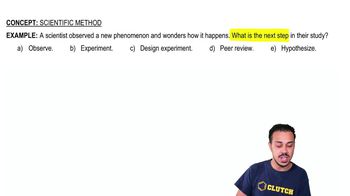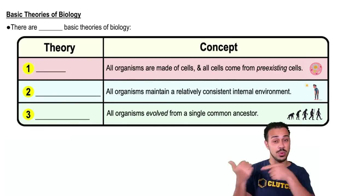Table of contents
- 1. Introduction to Biology2h 42m
- 2. Chemistry3h 40m
- 3. Water1h 26m
- 4. Biomolecules2h 23m
- 5. Cell Components2h 26m
- 6. The Membrane2h 31m
- 7. Energy and Metabolism2h 0m
- 8. Respiration2h 40m
- 9. Photosynthesis2h 49m
- 10. Cell Signaling59m
- 11. Cell Division2h 47m
- 12. Meiosis2h 0m
- 13. Mendelian Genetics4h 44m
- Introduction to Mendel's Experiments7m
- Genotype vs. Phenotype17m
- Punnett Squares13m
- Mendel's Experiments26m
- Mendel's Laws18m
- Monohybrid Crosses19m
- Test Crosses14m
- Dihybrid Crosses20m
- Punnett Square Probability26m
- Incomplete Dominance vs. Codominance20m
- Epistasis7m
- Non-Mendelian Genetics12m
- Pedigrees6m
- Autosomal Inheritance21m
- Sex-Linked Inheritance43m
- X-Inactivation9m
- 14. DNA Synthesis2h 27m
- 15. Gene Expression3h 20m
- 16. Regulation of Expression3h 31m
- Introduction to Regulation of Gene Expression13m
- Prokaryotic Gene Regulation via Operons27m
- The Lac Operon21m
- Glucose's Impact on Lac Operon25m
- The Trp Operon20m
- Review of the Lac Operon & Trp Operon11m
- Introduction to Eukaryotic Gene Regulation9m
- Eukaryotic Chromatin Modifications16m
- Eukaryotic Transcriptional Control22m
- Eukaryotic Post-Transcriptional Regulation28m
- Eukaryotic Post-Translational Regulation13m
- 17. Viruses37m
- 18. Biotechnology2h 58m
- 19. Genomics17m
- 20. Development1h 5m
- 21. Evolution3h 1m
- 22. Evolution of Populations3h 52m
- 23. Speciation1h 37m
- 24. History of Life on Earth2h 6m
- 25. Phylogeny2h 31m
- 26. Prokaryotes4h 59m
- 27. Protists1h 12m
- 28. Plants1h 22m
- 29. Fungi36m
- 30. Overview of Animals34m
- 31. Invertebrates1h 2m
- 32. Vertebrates50m
- 33. Plant Anatomy1h 3m
- 34. Vascular Plant Transport1h 2m
- 35. Soil37m
- 36. Plant Reproduction47m
- 37. Plant Sensation and Response1h 9m
- 38. Animal Form and Function1h 19m
- 39. Digestive System1h 10m
- 40. Circulatory System1h 57m
- 41. Immune System1h 12m
- 42. Osmoregulation and Excretion50m
- 43. Endocrine System1h 4m
- 44. Animal Reproduction1h 2m
- 45. Nervous System1h 55m
- 46. Sensory Systems46m
- 47. Muscle Systems23m
- 48. Ecology3h 11m
- Introduction to Ecology20m
- Biogeography14m
- Earth's Climate Patterns50m
- Introduction to Terrestrial Biomes10m
- Terrestrial Biomes: Near Equator13m
- Terrestrial Biomes: Temperate Regions10m
- Terrestrial Biomes: Northern Regions15m
- Introduction to Aquatic Biomes27m
- Freshwater Aquatic Biomes14m
- Marine Aquatic Biomes13m
- 49. Animal Behavior28m
- 50. Population Ecology3h 41m
- Introduction to Population Ecology28m
- Population Sampling Methods23m
- Life History12m
- Population Demography17m
- Factors Limiting Population Growth14m
- Introduction to Population Growth Models22m
- Linear Population Growth6m
- Exponential Population Growth29m
- Logistic Population Growth32m
- r/K Selection10m
- The Human Population22m
- 51. Community Ecology2h 46m
- Introduction to Community Ecology2m
- Introduction to Community Interactions9m
- Community Interactions: Competition (-/-)38m
- Community Interactions: Exploitation (+/-)23m
- Community Interactions: Mutualism (+/+) & Commensalism (+/0)9m
- Community Structure35m
- Community Dynamics26m
- Geographic Impact on Communities21m
- 52. Ecosystems2h 36m
- 53. Conservation Biology24m
1. Introduction to Biology
Scientific Method
Problem 7`
Textbook Question
Which sentence best describes the logic of scientific inquiry?
a. If I generate a testable hypothesis, tests and observations will support it.
b. If my prediction is correct, it will lead to a testable hypothesis.
c. If my observations are accurate, they will support my hypothesis.
d. If my hypothesis is correct, I can expect certain test results.
 Verified step by step guidance
Verified step by step guidance1
Understand the scientific method: The scientific method is a systematic process used for scientific inquiry. It involves making observations, forming a hypothesis, making predictions, conducting experiments, and drawing conclusions.
Identify the role of a hypothesis: A hypothesis is a testable statement that explains a phenomenon or a set of observations. It is a crucial part of the scientific method as it guides the design of experiments.
Recognize the importance of predictions: Predictions are specific outcomes that are expected if the hypothesis is correct. They are derived from the hypothesis and are used to design experiments.
Evaluate the options: Consider each option in the context of the scientific method. Option a suggests that tests and observations will support a hypothesis, which is not always true as hypotheses can be disproven. Option b implies that predictions lead to hypotheses, which is not the typical sequence. Option c suggests that accurate observations support a hypothesis, but observations alone do not confirm hypotheses. Option d states that if a hypothesis is correct, certain test results can be expected, aligning with the prediction step of the scientific method.
Select the best description: The logic of scientific inquiry involves forming a hypothesis, making predictions, and testing those predictions. Therefore, the sentence that best describes this process is option d: 'If my hypothesis is correct, I can expect certain test results.'
 Verified video answer for a similar problem:
Verified video answer for a similar problem:This video solution was recommended by our tutors as helpful for the problem above
Video duration:
1mPlay a video:
Was this helpful?
Key Concepts
Here are the essential concepts you must grasp in order to answer the question correctly.
Scientific Inquiry
Scientific inquiry is a systematic process used to investigate phenomena, acquire new knowledge, or correct and integrate previous knowledge. It involves formulating hypotheses, conducting experiments, making observations, and drawing conclusions. The goal is to develop reliable explanations and predictions about the natural world.
Recommended video:
Guided course

Scientific Method
Hypothesis
A hypothesis is a proposed explanation for a phenomenon, based on limited evidence as a starting point for further investigation. It is testable and falsifiable, meaning it can be supported or refuted through experimentation and observation. Hypotheses are crucial in scientific inquiry as they guide the design of experiments and the interpretation of results.
Recommended video:
Guided course

Predictions, Hypotheses, & Theories
Testable Predictions
Testable predictions are specific, measurable outcomes that are expected if a hypothesis is correct. They are derived from the hypothesis and are used to design experiments that can confirm or refute the hypothesis. The ability to make testable predictions is a key aspect of scientific inquiry, as it allows scientists to validate their hypotheses through empirical evidence.
Recommended video:
Guided course

Predictions, Hypotheses, & Theories
Related Videos
Related Practice












